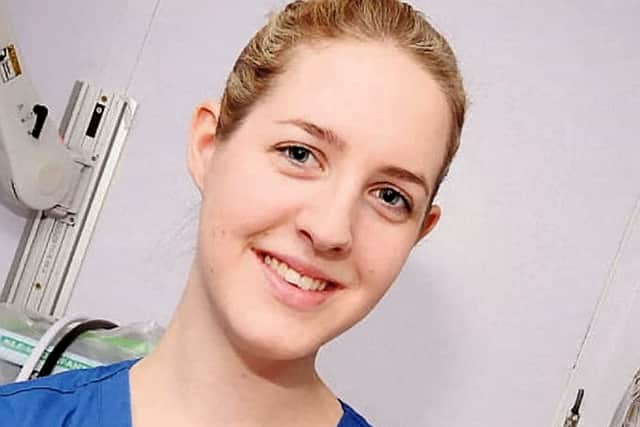Lucy Letby: trial of nurse accused of baby murders told of ‘unusual’ ‘line of gas’ in post-mortem X-ray
and live on Freeview channel 276
A line of gas in front of the spine was an “unusual finding” on the post-mortem X-ray of a baby allegedly murdered by nurse Lucy Letby, her trial has heard.
Paediatric radiologist Dr Owen Arthurs told Manchester Crown Court that its appearance was “consistent with, but not diagnostic, of air having been administered”.
Advertisement
Hide AdAdvertisement
Hide AdLetby, 32, is said by the prosecution to have injected air into the bloodstream of the newborn twin, Child A, who later collapsed and died on the evening of 8 June 2015, just more than 24 hours after his premature birth.
Letby is on trial accused of the murders of seven babies and the attempted murders of 10 others between June 2015 and June 2016 at the Countess of Chester Hospital’s neo-natal unit.
A court order prohibits reporting of the identities of surviving and dead children allegedly attacked by Letby, and also prohibits identifying parents or witnesses connected with the children. Letby, originally from Hereford, denies all the charges against her.


What was the jury told about the post-mortem?
Jurors were told that Dr Arthurs, professor of radiology at London’s Great Ormond Street Hospital, had been instructed to review X-rays taken of Child A – when alive and after death – as well as other babies in the investigation.
Advertisement
Hide AdAdvertisement
Hide AdLooking at one of the post-mortem X-rays, he highlighted to the court there was gas within the bowel – a normal feature, he said – and also the heart. Prosecutor Nick Johnson QC asked: “Anything unusual about the X-ray?”
Dr Arthurs replied: “You can also see a line of gas just in front of the spine. That is an unusual finding.” He said such an image would not be seen in deaths by natural causes but had been documented in cases of road traffic accidents and sepsis infection.
He went on: “In my opinion this was an unusual appearance. In the absence of any other explanation this appearance is consistent with, but not diagnostic, of air having been administered.”
Dr Arthurs said he could not say from the image alone that an air embolism – a gas bubble which enters a blood vessel – was the cause of Child A’s death.
Advertisement
Hide AdAdvertisement
Hide AdThe court has heard previously that Child A did not have intravenous fluids for up to four hours on 8 June before he received glucose through a “long line” plastic tube at 8.05pm – shortly after the defendant came on duty.
Earlier on the shift, a cannula to a blood vessel stopped working, followed by two failed attempts to correctly insert a catheter in the belly button. Dr Arthurs told the court it was “possible” that gas could have been introduced by one of those above devices.
Mr Johnson asked: “Have you ever seen this much gas in a baby that has not been explained?” Dr Arthurs replied: “Only in one other case.”
Mr Johnson said: “One of the other children in this case?” “That’s right,” replied the medic.
Advertisement
Hide AdAdvertisement
Hide AdDr Arthurs said he based his opinion on a published peer-reviewed study in 2015 which looked at how common it is that gas occurs in older children who have died, albeit with “very few babies” included in the study. He went on to review the deaths of 500 infants at Great Ormond Street.
The radiologist also reviewed the X-rays of Child A’s twin sister, Child B, who the Crown say Letby attempted to murder via an injection of air on the following night shift at the neo-natal unit.
Dr Arthurs said he found “no significant abnormalities” on her radiographic images, including on a X-ray taken 40 minutes after Child B suffered a sudden collapse, which the Crown say Letby was responsible for.
What other evidence was heard?
A nurse, who cannot be named for legal reasons, later told the jury she was on duty the night that Child A collapsed. Junior prosecutor Philip Astbury asked: “How did he look?”
Advertisement
Hide AdAdvertisement
Hide AdThe nurse replied: “I had never seen a baby look like that way before. He looked very ill. He had a discolouration pattern I had never seen before. It was purple blotchiness with white. It was everywhere. It came on very suddenly.” The trial was adjourned until Monday morning.
